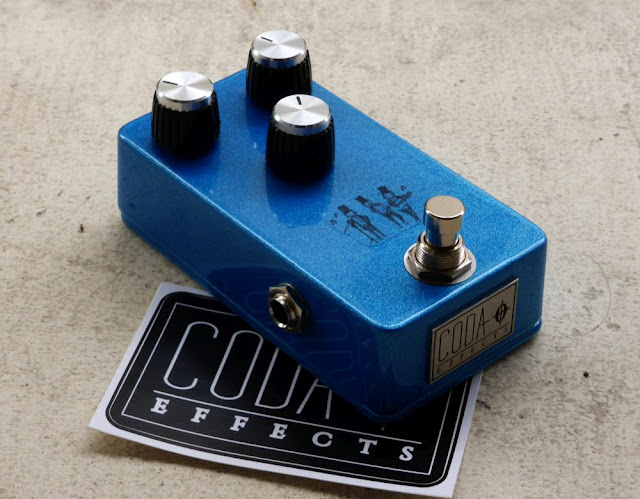Here is my last build: a Tonebender MKIII clone! The tonebender was initially a derivative of the Fuzz Face, a bit closer to an amp distorsion than a fuzz. (read my post about the different types of fuzz) It became quickly famous thanks to a lot of guitarists like Jimmy Page or Jeff Beck.
The MK2 version used two germanium transistors to get fuzzy tones. However, due to the nature of the circuit, the quality of the fuzz was very dependent on the transistor's gain and characteristics, just like in the Fuzz Face. In order to avoid the selection of transistors, the Mk3 version used 3 transistors, so that the quality of the sound is less dependent on the germanium transistors used. Here is my version:

I used a small sticker that I bought in London representing a small power trio :) I used the same knobs used on the original MKIII, and the blue of the Park Fuzz

And of course, my laser-engraved logo :)

If you are interested, I am selling it for 165 euros (free shipping, unique piece)
Inside, I used a Aion Electronic Phobos PCB. It is a very nice PCB (like most of the Aion Electronics PCBs!), with many options to turn it to a Baldwin-Burns Buzzaround, a Vox Tonebender MKIII, Park Fuzz Sound, or the Prescription Electronics Yard Box. Red and blue wiring to fit the color scheme.

I used 3 Telefunken AC116 germanium transistors. Their gain is perfect for this kind of build, and thay are slightly cheaper than AC128 transistors that are used for Fuzz Face guitar pedals. They also have quite a cool package, made to cool them easily.

How does it sound?
I made a quick video (not so good, sorry....)Like Fuzz Faces, it sounds really good on an overdriven amp, and has a warm, bassy fuzz feeling. It also reacts well to the guitar volume knob.
If you are interested, I am selling it for 165 euros (free shipping, unique piece)
How does it work?
Well, it is finally quite close to a Fuzz Face: a first stage amplifies the signal, which in returns makes the last transistor saturates: here is the fuzz! The main difference is that contrary to the Fuzz Face, the first stage is a 2 transistors amplification stage, and it amplifies the signal enough so you do not need a feedback loop to make it bigger.Lets see that in details.
Here is the schematic of the Tonebender:
And as usual, the schematic divided in functional parts:
So, the first stage amplifies the signal, which then makes the Q3 transistor saturates. Then, there is the tone control stage to remove of bit of trebles and fizziness, and finally a volume output stage. Notice that the circuit is in reverse polarity because germanium PNP transistors are used here.
Lets analyse each par one by one!
The amplification stage
The signal goes through a first C1 coupling capacitor, to avoid any parasitic DC current to go in the circuit. R1 and R2 form a voltage divider to bias the first Q1 transistor.
After this amplification stage, there is again a coupling capacitor (C2), and the Fuzz potentiometer allow to reduce the signal. When you turn the knob, the resistance of the potentiometer will increase and the signal will be "less amplified", and thus, you will get less saturation out of it.
The saturation stage
Now that the signal has been amplified a lot, it will hit the Q3 transistor and make it saturates, creating a beautiful fuzzy distortion that we love.
Tone section
The tone section helps to remove a bit of the trebles of the Fuzz, and avoid it to sound too gritty. It is a very nice addition that give the fuzz a bit more versatility!
It is a very simple layout that works quite well!
Output stage
Simple layout that we have already seen in the Fuzz Face circuit analysis.
There it is! I hope that you liked it.
If you have found this post useful, like Coda Effects Facebook page for more infos and updates!
To go further:
- History of Tonebenders by D*A*M stompboxes
- Tonebender timeline on the Big Muff page: very detailed historic of the Tonebender pedals
- Aion Electornics Phobos project page
- Fuzz central post about the Tonebender MK3



4 Comment
It’s unique to find an expert through whom you would have several trustworthiness. On this planet with the current economic week, none of us realistically cares about presenting others the result in such an subjecttopic. Precisely how fortuitous I’m sure having clearly spotted actually outstanding blog because. It’s individuals like you whom develop serious difference nowadays over the ideas which they explain. Electronics Quality Engineering
AnswerFirstly have to say I love reading your Bloggs Benoit, and I've appreciated the quality of your pcb's (have bought a few from you in the past) .. but, I felt I had to warn you that your opening statements on this page are a bit off-target!! .. do check back on the tonebender schematics! - the mk2 and mk3 definitely doesn't refer to the number of transistors - if that was the case where would the mk1 leave you??? - no, it has to do with its lineage (and you may choose then to relate it, for ease of reference, to the number of knobs)!!! - the mk1, mark2, mark3 and mk4 all have 3 germaniums (I know I've built mk1-mk3 and a supa fuzz), the difference is mainly in component arrangement and component values (as well as controls).
AnswerRegards
Nigel
Totally agree! English mispelling here, I think I wrote my sentence in a wrong way. Going to rewrite in a better way. Thank you for the comment Nigel!
AnswerWhat type of diode did you use for the power section (1n4742)? The number is a zener but the schematic from Aion doesn’t label it as a zener..
Answer